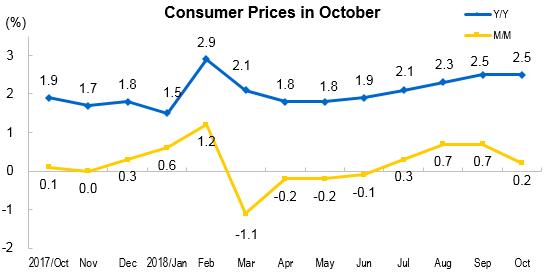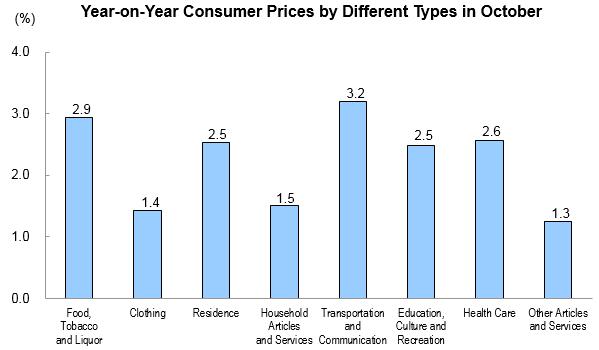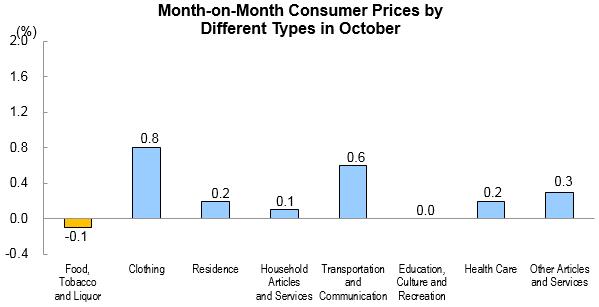Consumer Prices for October 2018
In October 2018, the consumer price index (CPI) went up by 2.5 percent year-on-year. The prices grew by 2.5 percent in cities and 2.6 percent in rural areas. The food prices went up by 3.3 percent, and the non-food prices increased 2.4 percent. The prices of consumer goods went up by 2.8 percent and the prices of services grew by 2.1 percent. On average from January to October, the overall consumer prices were up by 2.1 percent from the same period of the previous year.
In October, the consumer prices went up by 0.2 percent month-on-month. Of which, prices went up by 0.2 percent in cities and 0.2 percent in rural areas. The food prices went down by 0.3 percent, and the non-food prices went up by 0.3 percent. The prices of consumer goods increased 0.3 percent, and the prices of services unchanged from the previous month.

I. Year-on-Year Changes of Prices of Different Categories
Prices of food, tobacco and liquor went up by 2.9 percent year-on-year, affecting nearly 0.87 percentage point increase in the CPI. Of which, the prices of fresh fruits up by 11.5 percent, affecting nearly 0.18 percentage point increase in the CPI; fresh vegetables up by 10.1 percent, affecting nearly 0.25 percentage point increase in the CPI; eggs went up by 8.5 percent, affecting nearly 0.05 percentage point increase in the CPI; poultry, up by 4.3 percent, affecting nearly 0.05 percentage point increase in the CPI; grain, up by 0.6 percent, affecting nearly 0.01 percentage point increase in the CPI; meat, up by 0.4 percent, affecting nearly 0.02 percentage point increase in the CPI (price of pork was down by 1.3 percent, affecting nearly 0.03 percentage point decrease in the CPI).
The prices of all the other seven categories increased year-on-year. Of which, the price of transportation and communication, health care increased 3.2and 2.6 percent respectively, the prices of residence, education, culture and recreation all increased 2.5 percent, household articles and services, clothing and other articles and services increased 1.5, 1.4 and 1.3 percent respectively.

II. Month-on-Month Changes of Prices of Different Categories
Prices of food, tobacco and liquor went down by 0.1 percent month-on-month, affecting nearly 0.02 percentage point decrease in the CPI. Of which, prices for fresh fruits went up by 1.9 percent, affecting nearly 0.03 percentage point increase in the CPI; meat up by 1.0 percent, affecting nearly 0.05 percentage point increase in the CPI (price of pork was up by 1.0 percent, affecting nearly 0.02 percentage point increase in the CPI); fresh vegetables down by 3.5 percent, affecting nearly 0.10 percentage point decrease in the CPI; eggs down by 3.3 percent, affecting nearly 0.02 percentage point decrease in the CPI; Aquatic Products down by 0.9 percent, affecting nearly 0.02 percentage point decrease in the CPI.
Among the prices of the other seven categories, six increased, one unchanged month-on-month. Of which, the prices of clothing, transportation and communication, other articles and services increased 0.8, 0.6and 0.3 percent respectively; the prices of residence, health care, household articles and services increased 0.2, 0.2 and 0.1 percent respectively; education, culture and recreation unchanged from the previous month.

Consumer Prices in October
| Items | October | Average on Jan-Oct | |
| M/M (%) | Y/Y (%) | Y/Y (%) | |
|
| |||
| Consumer Prices | 0.2 | 2.5 | 2.1 |
| Of which: Urban | 0.2 | 2.5 | 2.1 |
| Rural | 0.2 | 2.6 | 2.1 |
| Of which: Food | -0.3 | 3.3 | 1.6 |
| Non food | 0.3 | 2.4 | 2.2 |
| Of which: Consumer Goods | 0.3 | 2.8 | 1.9 |
| Services | 0.0 | 2.1 | 2.6 |
| Of which: Excluding Food and Energy | 0.2 | 1.8 | 2.0 |
| Of which: Excluding Fresh Vegetables and Fresh Fruits | 0.3 | 2.2 | 1.9 |
| By Commodity Categories |
|
|
|
| I. Food, Tobacco and Liquor | -0.1 | 2.9 | 1.7 |
| Grain | 0.1 | 0.6 | 0.8 |
| Cooking Oil | 0.2 | -0.6 | -0.9 |
| Fresh Vegetables | -3.5 | 10.1 | 8.0 |
| Meat | 1.0 | 0.4 | -4.7 |
| Of which: Pork | 1.0 | -1.3 | -9.4 |
| Beef | 1.1 | 4.5 | 3.3 |
| Mutton | 1.8 | 9.9 | 12.9 |
| Aquatic Products | -0.9 | 0.8 | 2.3 |
| Eggs | -3.3 | 8.5 | 13.9 |
| Dairy products | 0.3 | 2.1 | 1.2 |
| Fresh Fruits | 1.9 | 11.5 | 4.5 |
| Tobacco | 0.0 | 0.2 | 0.1 |
| Liquor | 0.5 | 2.7 | 2.9 |
| II. Clothing | 0.8 | 1.4 | 1.2 |
| Clothing | 0.9 | 1.6 | 1.4 |
| Clothing Processing Service | 0.4 | 4.5 | 4.1 |
| Shoes | 0.6 | 0.7 | 0.4 |
| III. Residence | 0.2 | 2.5 | 2.4 |
| House Renting | 0.0 | 2.5 | 2.5 |
| Water, Electricity, and Fuel | 0.5 | 2.5 | 1.8 |
| IV. Household Articles and Services | 0.1 | 1.5 | 1.6 |
| Household Appliances | 0.0 | 0.3 | 0.5 |
| Household Services | 0.1 | 5.9 | 5.6 |
| V. Transportation and Communication | 0.6 | 3.2 | 1.9 |
| Transportation Facilities | 0.1 | -1.7 | -1.5 |
| Fuels for Vehicles | 4.2 | 22.0 | 14.0 |
| Vehicle Use and Maintenance | 0.1 | 2.9 | 2.7 |
| Communication Facilities | 0.6 | -1.0 | -2.3 |
| Communication Services | 0.0 | -1.7 | -1.1 |
| Postal Services | 0.2 | 1.0 | 2.1 |
| VI. Education, Culture and Recreation | 0.0 | 2.5 | 2.2 |
| Education Services | 0.2 | 3.2 | 2.8 |
| Tourism | -0.9 | 3.2 | 3.5 |
| VII. Health Care | 0.2 | 2.6 | 4.7 |
| Traditional Chinese Medicines | 0.5 | 6.3 | 5.5 |
| Western Medicines | 0.4 | 5.4 | 5.2 |
| Health Care Services | 0.0 | 1.2 | 5.0 |
| VIII. Other Articles and Services | 0.3 | 1.3 | 1.1 |
|
| |||
Annotations:
1. Explanatory Notes
Consumer Price Index (CPI) is an index measuring changes over time in the price level of consumer goods and services purchased by residents, which comprehensively reflects the changes of price level.
2. Statistical Coverage
Consumer Price Index (CPI) covers the prices of goods and services of 8 categories and 262 basic divisions which cover the living consumption of urban and rural residents, including food, tobacco and liquor; clothing; residence; household articles and services; transportation and communication; education, culture and recreation; health care; other articles and services.
3. Survey Methods
The prices collection units are selected and determined by sample survey methods, and the original data of consumer prices are collected by specific person in fixed place at fixed time. Data are collected from 88,000 prices collection units in 500 cities and counties of the 31 provinces (autonomous regions and municipalities), which cover shopping malls, supermarkets, open fairs, service outlets and Internet E-commerce suppliers.
